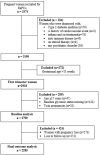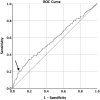Early pregnancy hyperglycaemia as a significant predictor of large for gestational age neonates
- PMID: 34973071
- PMCID: PMC8917036
- DOI: 10.1007/s00592-021-01828-1
Early pregnancy hyperglycaemia as a significant predictor of large for gestational age neonates
Abstract
Aims: We aimed to determine the effect of early pregnancy hyperglycaemia on having a large for gestational age (LGA) neonate.
Methods: A prospective cohort study was conducted among pregnant women in their first trimester. One-step plasma glucose (PG) evaluation procedure was performed to assess gestational diabetes mellitus (GDM) and diabetes mellitus (DM) in pregnancy as defined by the World Health Organization (WHO) criteria with International Association of Diabetes in Pregnancy Study Group (IADPSG) thresholds. The main outcome studied was large for gestational age neonates (LGA).
Results: A total of 2,709 participants were recruited with a mean age of 28 years (SD = 5.4) and a median gestational age (GA) of eight weeks (interquartile range [IQR] = 2). The prevalence of GDM in first trimester (T1) was 15.0% (95% confidence interval [CI] = 13.7-16.4). Previously undiagnosed DM was detected among 2.5% of the participants. Out of 2,285 live births with a median delivery GA of 38 weeks (IQR = 3), 7.0% were LGA neonates. The cumulative incidence of LGA neonates in women with GDM and DM was 11.1 and 15.5 per 100 women, respectively. The relative risk of having an LGA neonate among women with DM and GDM was 2.30 (95% CI = 1.23-4.28) and 1.80 (95% CI = 1.27-2.53), respectively. The attributable risk percentage of a LGA neonate for hyperglycaemia was 15.01%. T1 fasting PG was significantly correlated with both neonatal birth weight and birth weight centile.
Conclusions: The proposed WHO criteria for hyperglycaemia in pregnancy are valid, even in T1, for predicting LGA neonates. The use of IADPSG threshold for Fasting PG, for risk assessment in early pregnancy in high-risk populations is recommended.
Keywords: First trimester; Gestational diabetes mellitus; Hyperglycaemia; Large for gestational age; Pregnancy.
© 2021. The Author(s).
Conflict of interest statement
The authors declare that they have no conflict of interest.
Figures
Similar articles
-
Heterogeneity of pregnancy outcomes and risk of LGA neonates in Caucasian females according to IADPSG criteria for gestational diabetes mellitus.Diabetes Metab. 2013 Apr;39(2):132-8. doi: 10.1016/j.diabet.2012.09.006. Epub 2012 Nov 22. Diabetes Metab. 2013. PMID: 23182459
-
[Diagnostic of gestational diabetes mellitus and the prevalence of LGA (Large for Gestational Age)].Ginekol Pol. 2008 Mar;79(3):177-81. Ginekol Pol. 2008. PMID: 18592851 Polish.
-
Birth weight and large for gestational age trends in offspring of pregnant women with gestational diabetes mellitus in southern China, 2012-2021.Front Endocrinol (Lausanne). 2023 May 4;14:1166533. doi: 10.3389/fendo.2023.1166533. eCollection 2023. Front Endocrinol (Lausanne). 2023. PMID: 37214242 Free PMC article.
-
Screening and diagnosing gestational diabetes mellitus.Evid Rep Technol Assess (Full Rep). 2012 Oct;(210):1-327. Evid Rep Technol Assess (Full Rep). 2012. PMID: 24423035 Free PMC article. Review.
-
Effects of different dietary patterns during pregnancy on birth outcomes and glucose parameters in women with gestational diabetes mellitus: A systematic review and meta-analysis.Prim Care Diabetes. 2023 Aug;17(4):287-308. doi: 10.1016/j.pcd.2023.04.005. Epub 2023 Apr 29. Prim Care Diabetes. 2023. PMID: 37127452
Cited by
-
Effect of Maternal Glucose and Triglyceride Levels during Early Pregnancy on Pregnancy Outcomes: A Retrospective Cohort Study.Nutrients. 2022 Aug 11;14(16):3295. doi: 10.3390/nu14163295. Nutrients. 2022. PMID: 36014801 Free PMC article.
-
Early pregnancy metabolic syndrome and risk for adverse pregnancy outcomes: findings from Rajarata Pregnancy Cohort (RaPCo) in Sri Lanka.BMC Pregnancy Childbirth. 2023 Apr 5;23(1):231. doi: 10.1186/s12884-023-05548-y. BMC Pregnancy Childbirth. 2023. PMID: 37020187 Free PMC article.
-
The effect of early pregnancy ALT elevation on neonatal birth weight: The mediating role of gestational diabetes mellitus.PLoS One. 2025 May 14;20(5):e0322581. doi: 10.1371/journal.pone.0322581. eCollection 2025. PLoS One. 2025. PMID: 40367133 Free PMC article.
-
Demographic, socio-economic, obstetric, and behavioral factors associated with small-and large-for-gestational-age from a prospective, population-based pregnancy cohort in rural Nepal: a secondary data analysis.BMC Pregnancy Childbirth. 2022 Aug 19;22(1):652. doi: 10.1186/s12884-022-04974-8. BMC Pregnancy Childbirth. 2022. PMID: 35986258 Free PMC article. Clinical Trial.
-
Associations between maternal metabolic parameters during pregnancy and fetal and child growth trajectories from 20 weeks' gestation to 5 years of age: Secondary analysis from the ROLO longitudinal birth cohort study.Pediatr Obes. 2023 Jan;18(1):e12976. doi: 10.1111/ijpo.12976. Epub 2022 Sep 14. Pediatr Obes. 2023. PMID: 36102219 Free PMC article.
References
-
- Ginige S, Wijeyaratne K, Wijeyaratne CN. Prevalence of gestational diabetes mellitus in Homagama Divisional Director of Health Service area. J Coll Community Phys Sri Lanka. 2004;9:40. doi: 10.4038/JCCPSL.V9I1.8278. - DOI
MeSH terms
Grants and funding
LinkOut - more resources
Full Text Sources
Medical




